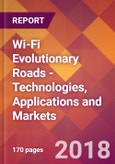This report addresses advanced developments in one of the most established and powerful wireless technology - Wi-Fi. Originated in the 20s century, this WLAN family belongs to a very small group of communications technologies that do not getting obsolete with time. The family continues to grow adding new members that bring WLAN to the forefront of today innovations in communications with multiple applications and pushing up the limits in performance.
The report goal is to analyze recently introduced or still in the development advanced Wi-Fi technologies, their applications and marketplace. It also surveys related industries.
In particular, it addresses such developments as:
802.11n. The technology already produced a multi-billion market, improving such communications characteristics as the rate of transmission, coverage and other. It significantly increased the spectrum of Wi-Fi applications. In the recent years, 802.11n products dominated the Wi-Fi market; but this technology is gradually losing its leading position to newer members of the Wi-Fi family, such as:
- 60 GHz Wi-Fi - 802.11ad. This is the Wi-Fi industry response on the users’ new requirements to support gigabits per second transmission rates over shorter ranges for such applications as a home/office distribution of HDVD and similar bandwidth-hunger applications. The report addresses specifics of 60 GHz channels and details WiGig/802.11ad technology. It also introduces NG 60 GHz 802.11ay standard.
- White Spaces Wi-Fi (White Wi-Fi - 802.11af). This technology allows utilizing the property of sub-gigahertz transmission together with Wi-Fi advances. It utilizes unused windows of the TV spectrum and in a future will work with Cognitive Radios.
- Sub - 6 GHz Wi-Fi - 802.11ac. This development allows gigabits per second speed and improves characteristics of IEEE 802.11n technology in the wide spectrum of characteristics.
- Sub - 1 GHz Wi-Fi (excluding White Spaces) - 802.11ah.
- IEEE standards in the development: P802.11ax, which stretch Wi-Fi characteristics beyond imaginable just a few years ago.
- WAVE 802.11p - Dedicated Short Reach Communications 5.9 GHz- contribution of Wi-Fi to the development of the connected car.
- Other.
The report details technical and marketing specifics of these types of WLAN technologies as well as surveys their industries.
The report was developed for technical and managerial personnel working on the Wi-Fi related projects to give them better understanding specifics of this family technologies and markets.
The report also includes the survey of 2016-2018 patents related to discussed technologies.
Table of Contents
Companies Mentioned
- Aerohive
- Arada
- Arinc (Rockwell Collins)
- Aruba-HP
- Asus
- AutoTalks
- Aviacomm
- Blu Wireless
- Broadcom
- Buffalo
- Carlson Wireless
- Cisco
- Cohda Wireless
- Commsignia
- D-Link
- Huawei
- Intel
- Kapsch
- Lattice
- Linksys
- Marvell
- Morse Micro
- Motorola Solutions
- NXP
- Netgear
- Newracom-Aviacomma
- Nitero (acquired by AMD in 2017)
- Peraso
- Qorvo
- Qualcomm
- Quantenna
- Redpine Signals
- TP-Link
- Tensorcom
- TrendNet
- Unex
- ZyXel
Methodology
Considerable research was done using the Internet. Information from various Web sites was studied and analyzed; evaluation of publicly available marketing and technical publications was conducted.
Telephone conversations and interviews were held with industry analysts, technical experts and executives. In addition to these interviews and primary research, secondary sources were used to develop a more complete mosaic of the market landscape, including industry and trade publications, conferences and seminars.
The overriding objective throughout the work has been to provide valid and relevant information. This has led to a continual review and update of the information content.

LOADING...








